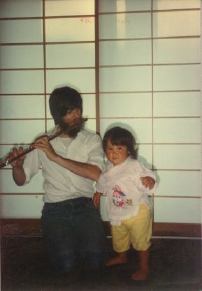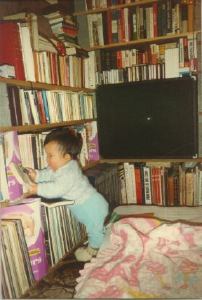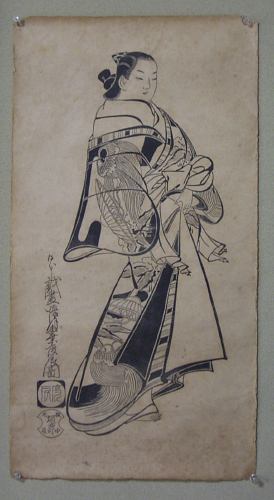... (continued from previous issue) ...
The events I have been writing about - working as the manager of the music store while exploring the woodblock printmaking 'hobby' - took place some twenty-odd years ago, so it's a bit difficult for me to recapture exactly what I was thinking and planning at the time. I'm a fairly good record keeper though, and down in my basement here in Ome there are a few things stashed away in boxes that are helping to jog my memory!
 Exhibit #1, a photo taken in our tiny 'apartment' room. Eh? Shoji screens in a Canadian apartment? Well, they certainly weren't there when I moved in! I guess I was pretty infatuated with 'things Japanese' at that time, and rather than hanging curtains on the window, I built this screen. (It was very well made too, using no nails or glue; everything fit together very tightly) As for that flute, I wonder if 'little' Himi-chan has any memory at all of her father playing a musical instrument? I very much doubt it, as a year or so after this picture was taken, the flute went into a box, where it has remained ever since ...
Exhibit #1, a photo taken in our tiny 'apartment' room. Eh? Shoji screens in a Canadian apartment? Well, they certainly weren't there when I moved in! I guess I was pretty infatuated with 'things Japanese' at that time, and rather than hanging curtains on the window, I built this screen. (It was very well made too, using no nails or glue; everything fit together very tightly) As for that flute, I wonder if 'little' Himi-chan has any memory at all of her father playing a musical instrument? I very much doubt it, as a year or so after this picture was taken, the flute went into a box, where it has remained ever since ...
 Exhibit #2, another photo of the room. I had been ransacking used bookshops for anything related to Japan, Japanese history, or Japanese art, and those shelves climbed higher by the week. I can remember how eagerly I buried my nose in those books ... this guy who can't stand 'studying'. If I had been assigned such a task by a teacher, I would have given up, but when you are following your own nose, things are so different!
Exhibit #2, another photo of the room. I had been ransacking used bookshops for anything related to Japan, Japanese history, or Japanese art, and those shelves climbed higher by the week. I can remember how eagerly I buried my nose in those books ... this guy who can't stand 'studying'. If I had been assigned such a task by a teacher, I would have given up, but when you are following your own nose, things are so different!
 Exhibit #3, a print I made reproducing a Kaigetsudo design. I had planned this one for years in advance, ordering a large block specifically for it during that earlier trip to Japan. This print was made in mid-1984, and as things turned out, it would be pretty much the last print I would make for two years; except for a small greeting card that winter, I would not touch knife to wood again until we were in Japan ...
Exhibit #3, a print I made reproducing a Kaigetsudo design. I had planned this one for years in advance, ordering a large block specifically for it during that earlier trip to Japan. This print was made in mid-1984, and as things turned out, it would be pretty much the last print I would make for two years; except for a small greeting card that winter, I would not touch knife to wood again until we were in Japan ...
Why not? If I was so crazy about these Japanese prints, why wasn't I making more of them? My focus had changed a bit - because I didn't want to be in a situation where I was making prints as a hobby on the weekends, but rather wanted to be living prints, living and breathing them, I turned my energies towards figuring out a way to get an income from printmaking. And that leads to one more item I found stored downstairs: a binder full of records from my next endeavour - travelling woodblock print salesman!
The owner of the music store knew that I was toying with the idea of trying to become a full-time printmaker. He had even given me that previous three month leave, knowing full well that I was 'scouting out' the scene in Japan to learn what I could. It is indicative of just how tolerant he was that not only did he not complain about these activities, but even assisted them.
It seemed to me that people attending many of the craft fairs that were held at various locations around the province would be interested in seeing a woodblock print craftsman at work, so I matted and framed a selection of my prints, prepared a knock-down display unit on which I could show them along with explanatory materials, set up bank and sales tax accounts, collected all the information on fairs that I could get my hands on, sent off a batch of application forms, and started a side-career as a printmaker craftsman, scheduling my days off from the music store to coincide with the dates of the fairs to which I attended.
How did I do? Well ... looking at the last page in the accounts book, showing the total sales after a year of this ... $133.23 ...
Now what to do?
... continued next time ...